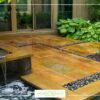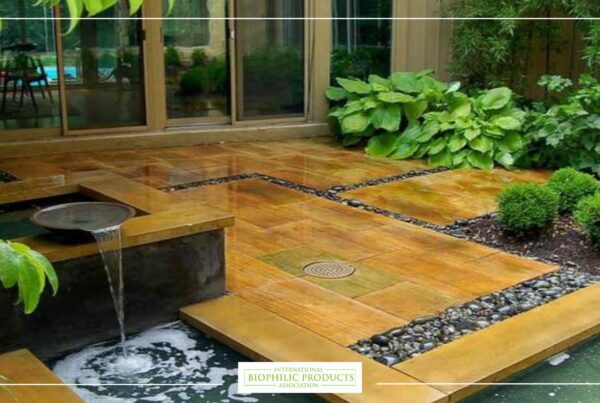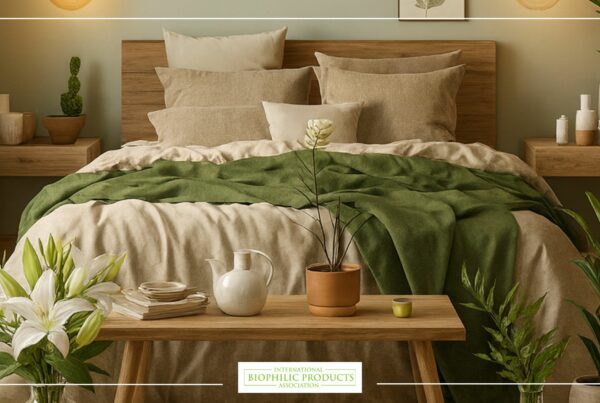Biophilic design has been called the architecture of well-being, an approach that blends the built environment with the natural world to enhance health, mood, and productivity. At its core, it’s not just about making a room look like nature, but about creating real, multisensory connections with it.
While synthetic materials can sometimes mimic the look of nature, they rarely offer the same physical and psychological benefits as the natural materials they imitate. And research backs this up: humans evolved alongside stone, timber, water, plants, and other natural elements, developing sensory skills that can detect subtle differences between genuine and artificial.
In this article, we’ll explore why authenticity matters in biophilic interior design, how our senses respond to the real thing, and how designers can avoid falling into the “fake nature” trap.
The human instinct for authenticity
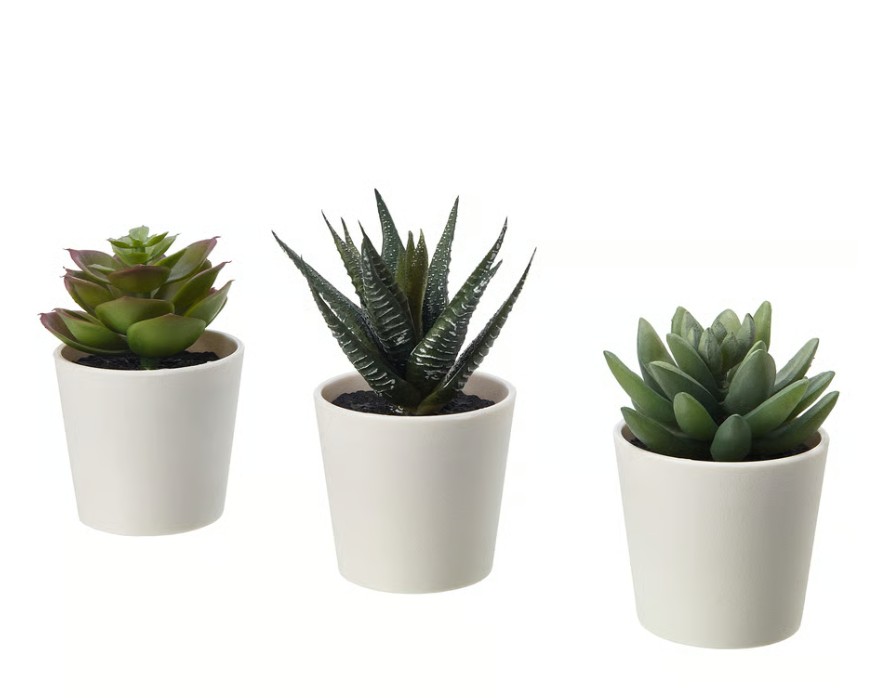
The term biophilia, popularized by Harvard biologist Edward O. Wilson in the 1980s, describes our innate affinity for life and living systems. For hundreds of thousands of years, our survival depended on reading environmental cues, recognizing which plants were edible, which surfaces were safe to walk on, and which textures signaled shelter or danger.
Even without touching, we can often “read” a material:
- A wool rug looks soft and warm.
- A marble countertop appears cool and hard.
- A worn leather chair suggests warmth and durability.
This sensory intelligence means we unconsciously notice when something feels “off.” While modern printing and manufacturing can replicate grain, color, and texture, they can’t always duplicate the micro-irregularities and tactile feedback that make the real thing so satisfying.
A 2000s study on visual recognition found that participants could distinguish real fruit from high-quality replicas, even in photographs where color and shape were nearly identical. The difference wasn’t always conscious, it was an intuitive, split-second judgment.
Why natural materials matter in biophilic design
In biophilic design, material choice is more than an aesthetic decision; it’s about delivering a true sensory connection. Real wood, stone, clay, wool, and cotton all carry subtle variations in color, scent, and texture that synthetic substitutes struggle to match.
1. Visual complexity
Natural materials display fractal patterns and organic imperfections that hold our attention. A single plank of oak contains thousands of unique grain variations, something no laminate sheet can fully capture.
2. Tactile honesty
Touching natural stone feels cool and solid because of its thermal properties; synthetic stone lacks this same thermal conductivity. Wool fibers bend and spring under pressure, unlike acrylic alternatives.
3. Aging gracefully
Real materials develop patina, the soft sheen on worn leather, the weathering of cedar, which adds character over time. Artificial materials often deteriorate rather than improve with age.
Craft + biophilia: the human connection
One of the most powerful bridges between people and nature in design is craft. Skilled artisans know their natural materials intimately, the way a greenwood branch bends for weaving, or how certain stones break cleanly along a grain.
When craft meets biophilic design, the results are spaces that feel human-centered and alive. A hand-carved wooden bench doesn’t just provide seating; it embodies a relationship between the maker, the tree it came from, and the person using it.
Mass production, in contrast, often strips away these layers of meaning, creating objects that may look right but feel emotionally flat.
The research: real vs. simulated nature
The Human Spaces Report found that workplaces with natural elements like sunlight, greenery, and water features saw:
- 15% higher well-being
- 6% more productivity
- 15% greater creativity
Interestingly, while simulated nature, such as nature-themed images or videos, can improve mood compared to having no nature at all, the physiological responses are stronger with real elements. One University of Washington study found that while viewing a real garden and a high-definition video of that same garden both reduced stress, the real view produced greater physical relaxation, such as lower heart rate and cortisol levels.
The risks of “faking it” in biophilic interior design
While imitation can serve a purpose, over-reliance on it can undermine the core goals of biophilic design.
1. Missed health benefits
Artificial plants don’t clean the air. Vinyl flooring printed to look like wood doesn’t have the same acoustic, thermal, or tactile qualities.
2. Shallow engagement
We connect more deeply with materials and forms that respond to us, the way sunlight shifts across a stone floor, or the way real leaves move in a breeze.
3. Perceived inauthenticity
Clients and occupants may not always articulate why, but they can sense when a space feels “fake,” reducing emotional attachment to it.
When authenticity isn’t possible
Budget, climate, and maintenance needs sometimes make natural materials impractical. In these cases, the designer’s job is to maximize sensory richness even with limitations:
- Pair high-quality imitations with real elements in high-touch areas.
- Use natural light, airflow, and soundscapes to reinforce nature’s presence.
- Incorporate scents from essential oils or natural materials.
Case studies: Authenticity in action
1. Genzyme Center, Cambridge, MA
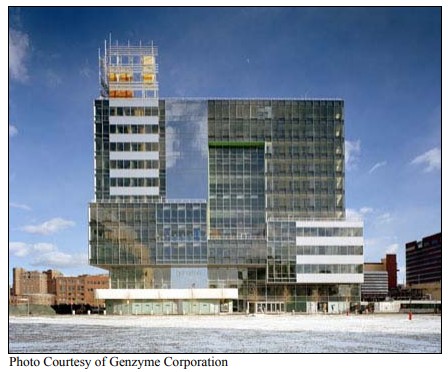
This LEED Platinum building integrates real indoor gardens, water features, and abundant daylight. Post-occupancy surveys showed 88% of staff felt their well-being improved due to the connection with real natural elements.
2. Bosco Verticale, Milan
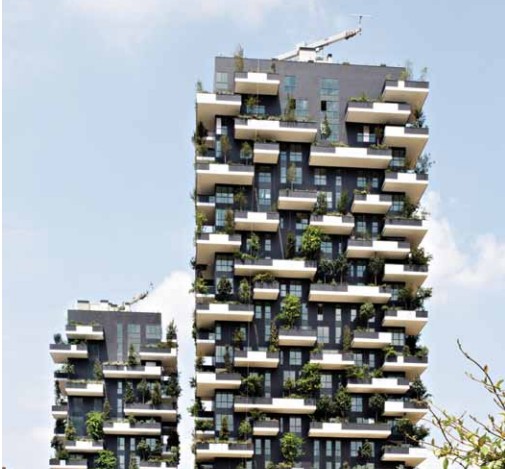
Housing over 900 trees, this residential tower not only improves air quality but also moderates internal temperature naturally. The planting is real, seasonal, and dynamic, qualities that no painted mural could provide.
Designing for authentic biophilia: A practical framework
1. Prioritize direct nature
Whenever possible, use actual plants, water, and raw materials.
2. Celebrate imperfections
Choose materials that display natural variation, from knots in wood to mineral streaks in stone.
3. Blend craft and technology
Work with artisans for feature elements, and use technology to support sustainability.
4. Think multisensory
Engage sight, touch, sound, and smell to deepen the connection.
5. Localize your approach
Use materials native to the region to strengthen ecological and cultural ties.
The bottom line
Biophilic design isn’t about decorating with “nature-themed” products. It’s about fostering a real, living relationship between people and the natural world. While imitation materials can help in certain contexts, they can’t fully replicate the benefits of authentic natural elements.If you want to design spaces that truly support well-being, creativity, and productivity, start with real nature, real materials, and real connections.
Join the biophilic movement and discover how you can transform your home or office into a thriving, nature‑connected space.



